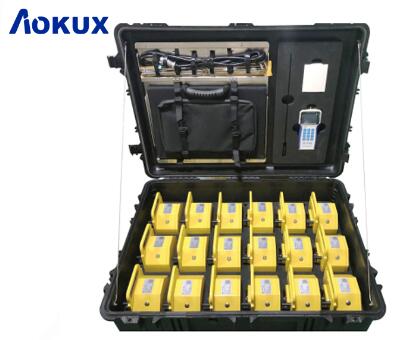
Portable airfield lighting is a crucial component in modern aviation, offering flexibility, safety, and operational efficiency, especially in remote, temporary, and emergency airfield operations. These systems are designed to provide reliable and effective lighting solutions that can be quickly deployed and configured, ensuring that airfield operations can continue under various conditions. This article delves into the importance of portable airfield lighting, its applications, components, technological advancements, and the challenges and future directions in this field.
The Importance of Portable Airfield Lighting
Portable airfield lighting systems are essential for several reasons:
Flexibility and Mobility: Unlike permanent lighting systems, portable airfield lighting can be quickly deployed, relocated, and adjusted as needed. This flexibility is particularly valuable in military operations, disaster response, and temporary airfields where conditions and requirements can change rapidly.
Safety Enhancement: Proper lighting is crucial for safe aircraft operations during nighttime or low-visibility conditions. Portable airfield lighting systems ensure that runways, taxiways, and other critical areas are adequately illuminated, reducing the risk of accidents and enhancing overall safety.
Operational Continuity: In the event of a failure of permanent lighting systems, portable airfield lighting can serve as a backup, ensuring that airfield operations can continue without significant disruptions.
Cost-Effectiveness: Portable airfield lighting systems can be more cost-effective than installing permanent lighting, especially for temporary or infrequent use scenarios. They also offer a quicker and less invasive installation process, saving time and resources.
Applications of Portable Airfield Lighting
Portable airfield lighting systems are used in a variety of applications:
Military Operations: In military contexts, portable airfield lighting is critical for establishing temporary airfields and forward operating bases. These systems support night operations and enhance the safety and efficiency of military logistics and air combat missions.
Disaster Response and Humanitarian Aid: During natural disasters or humanitarian crises, rapid deployment of airfield lighting is essential to support relief efforts. Portable lighting systems enable aircraft to operate around the clock, delivering aid and evacuating victims even under challenging conditions.
Temporary Airfields and Remote Locations: Construction projects, remote mining operations, and other activities in isolated areas often require temporary airfields. Portable lighting ensures these airfields can function safely and effectively, regardless of their location.
Event and Emergency Services: Major events, airshows, and emergency services operations often require temporary airfield lighting to manage increased air traffic and ensure the safety of aircraft and personnel.

Components of Portable Airfield Lighting Systems
Portable airfield lighting systems typically consist of several key components:
Runway and Taxiway Lights: These lights are essential for marking the edges and thresholds of runways and taxiways, guiding pilots during takeoff, landing, and taxiing. They are often equipped with high-intensity LEDs for maximum visibility.
Approach Lighting Systems (ALS): Approach lights help pilots align with the runway during landing, especially in poor visibility conditions. Portable ALS units are designed for quick deployment and adjustment.
Control and Monitoring Systems: Modern portable airfield lighting systems include control and monitoring units that allow operators to manage the lighting remotely. These systems often feature wireless communication, enabling adjustments to lighting intensity and patterns as needed.
Power Supply: Portable lighting systems require reliable power sources. They often include battery packs, solar panels, or portable generators to ensure continuous operation.
Portable Light Towers: For broader area illumination, portable light towers are used. These towers are equipped with powerful lights and can be quickly erected and adjusted to illuminate large areas such as aprons, parking areas, and maintenance zones.
Technological Advancements
Several technological advancements have significantly enhanced the performance and reliability of portable airfield lighting systems:
LED Technology: The adoption of LED lights has revolutionized airfield lighting. LEDs offer superior brightness, energy efficiency, and durability compared to traditional lighting options. They also have a longer lifespan and require less maintenance, making them ideal for portable applications.
Solar Power Integration: Solar-powered portable lighting systems are increasingly popular, especially in remote and off-grid locations. Advances in solar panel and battery technology have made these systems more reliable and efficient, reducing the reliance on fuel-based generators and minimizing environmental impact.
Wireless Control and Monitoring: The integration of wireless technology allows for remote control and monitoring of portable lighting systems. This capability enhances operational flexibility and enables quick adjustments to lighting configurations in response to changing conditions.
Advanced Optics and Light Distribution: Modern portable lighting systems feature advanced optics and light distribution technologies that enhance visibility and reduce glare. These innovations improve pilot perception and safety during night operations.
Modular and Scalable Designs: Portable lighting systems are now available in modular and scalable designs, allowing operators to configure the lighting setup according to specific requirements. This flexibility ensures that the system can adapt to different airfield layouts and operational needs.
Challenges and Future Directions
Despite significant advancements, several challenges remain in the implementation and operation of portable airfield lighting systems:
Environmental Conditions: Portable lighting systems must withstand harsh environmental conditions, including extreme temperatures, high winds, and heavy rain. Ensuring the durability and reliability of these systems in diverse environments is an ongoing challenge.
Battery Life and Power Management: While solar and battery technologies have improved, managing power consumption and ensuring sufficient battery life for extended operations remain critical concerns. Advances in energy storage and management are needed to address these issues.
|
portable airfield lighting |
1 |
| 2 | 3 |
| 4 | 6 |